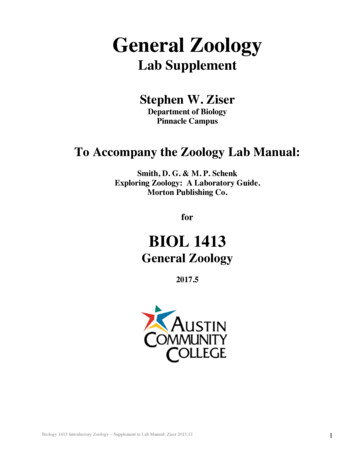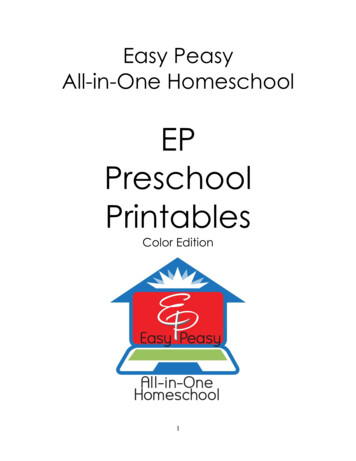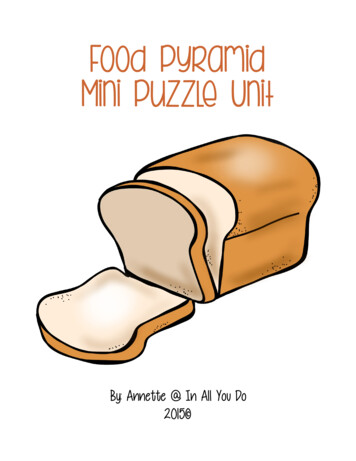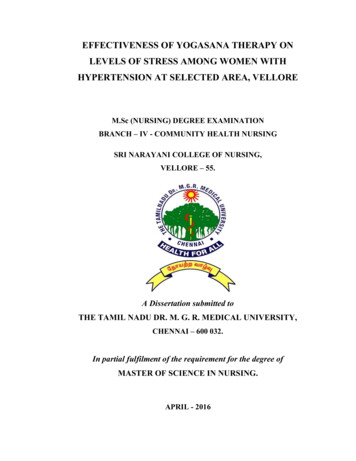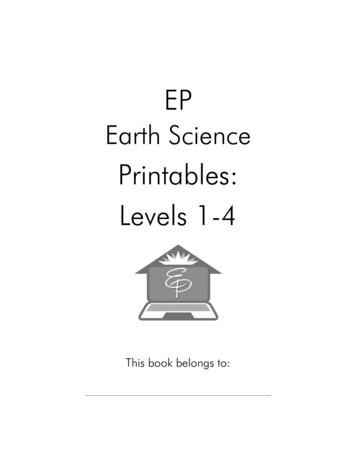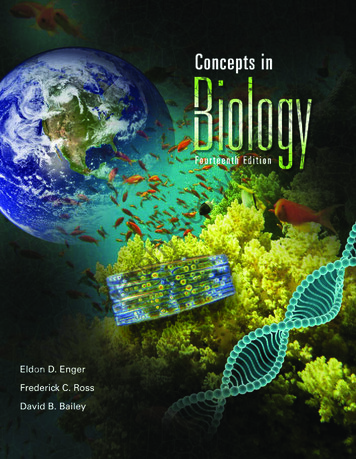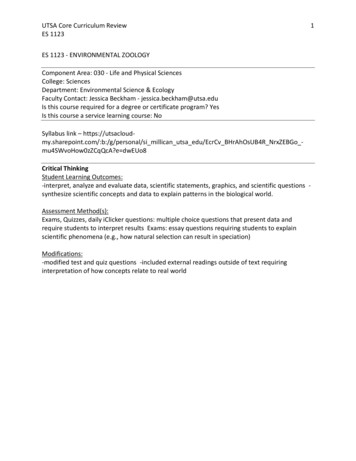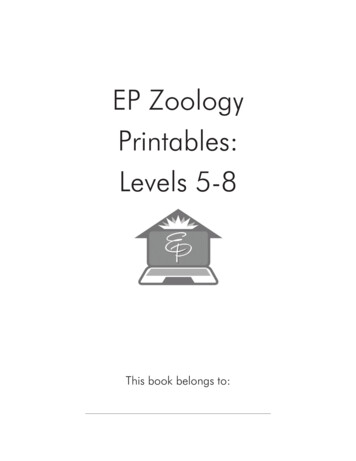
Transcription
EP ZoologyPrintables:Levels 5-8This book belongs to:
This book was made for your convenience. It is available for printing from theEasy Peasy All-in-One Homeschool website. It contains all of the printables fromEasy Peasy’s zoology course. The instructions for each page are found in theonline course.Easy Peasy All-in-One Homeschool is a free online homeschool curriculumproviding high quality education for children around the globe. It providescomplete courses for preschool through high school graduation. For EP’scurriculum visit allinonehomeschool.com.EP Zoology Printables: Levels 5-8Copyright 2020All rights reserved.This workbook, made by Tina Rutherford with permission from Easy Peasy All-in-OneHomeschool, is based on the zoology component of Easy Peasy’s curriculum.For EP’s online curriculum visit allinonehomeschool.com.This book may not be reproduced in whole or in part in any manner whatsoever withoutwritten permission from Easy Peasy.ISBN: 9798640339970First Edition: June 2020
Lesson2ZoologyLevels 5-8Mammal ClassificationCut out each hexagon and sort the mammals by category.MonotremesMarsupialslay eggshave pouchesCarnivoresPinnipedseat meathave flippersUngulatesPrimateshave hooveshave forward-facingeyes, opposablethumbs, and bigbrains
Lesson2ZoologyLevels 5-8Mammal ClassificationCetaceansSireniansaquatic, haveblowholeslarge, herbivorous,water-dwellingRodentsInsectivoresHave large incisorsfor gnawingSmall, eat insectsand other smallanimalsplatypuslion
Lesson2ZoologyLevels 5-8Mammal hin
Lesson2ZoologyLevels 5-8Mammal Classificationlemurkangaroobearapecowwhale
Lesson2ZoologyLevels 5-8Mammal Classificationmolezebracapybarasealbadgerpig
Lesson2ZoologyLevels 5-8Mammal Classificationprairie dogcamelbeaverrhinohedgehogmonkey
Lesson3ZoologyLevels 5-8Invertebrate ClassificationCut out each hexagon and sort the invertebrates by category.ArthropodsMollusksjointed legs and anexoskeletonsoft-bodied,sometimes haveshellsWormsEchinodermslong cylindrical tubelike body, no limbs,and no eyesspiny-skinned,suction-tubed ,tentacles, stingingcells
Lesson3ZoologyLevels 5-8Invertebrate opusstarfish
Lesson3ZoologyLevels 5-8Invertebrate Classificationcentipedesea anemonesea urchinlobstergrasshoppersnail
Lesson3ZoologyLevels 5-8Invertebrate Classificationsand dollarspidercoralconchcrabladybug
Lesson4ZoologyLevels 5-8What Did You Learn?Fill in the blank with the word that best ilesbirdshave a backbonehave hair; give birth to live youngair-breathing; covered with scaleslargest group of animalsdon’t have a backbonehave feathers; lay eggssoft-bodied or shelledpores throughout their bodieslive in the water all their livesvertebratesmollusks
Lesson12ZoologyLevels 5-8Endangered Species12Cut the pages on the dotted lines and place them in this pattern: 3 4 Using asingle six-sided die and whatever markers you can gather (coins, different rocks,pawns from other games, etc.), take turns rolling and moving the number on thedie. Follow the directions on the square you land on. Requested facts can befound throughout the board. Can you all get to the end before you go extinct?STARTTell someone afact about thegoliath frog.Tell someone afact about thepronghorn.- The black-ffaced impala is a raresubspecies of impala, making itdesirable to trophy hunters.- Impalas are known for theirleaps which can span 30 feet.- Herds range in size from 3 to 15and are found in Africa.Tell someone afact about thecheetah.Tell someonethree threats toendangeredanimals.Tell someone afact about anymammal.1
Lesson12ZoologyLevels 5-8Tell someone afact about anAfrican animal.Tell someone afact about theimpala.Your species movesfrom the threatenedlist to the endangeredlist. Lose a turn!Tell someone afact about a nonmammal.Tell someonethree threats toendangeredanimals.- The Sonoran pronghorn is oneof the most endangered animals inthe United States.- The pronghorn is the fastest landanimal in North America.- Drought is its biggest threat.Tell someone afact about thecockatoo.Tell someone afact about theblue whale.Move forwardthree spaces andread that square.2Catch a poacherin the act andsave an elephant.Roll again!
Lesson12ZoologyLevels 5-83Tell someone afact about thegoliath frog.Tell someone afact about a nonmammal.Tell someone afact about theimpala.- The blue whale is the largestanimal known to have existed.- Whaling (hunting whales fortheir usable products) is its biggestthreat.- Seen regularly off the coast ofCalifornia.FINISHRecite three thingsyou’ve learned and yourspecies will survive!- The white cockatoo is one ofseveral endangered cockatoospecies.- Its beauty makes it desirable forthe pet trade- Found in the Philippines,Indonesia, and Australia.Tell any fact thathasn’t been toldso far to avoidextinction!Tell someonethree threats toendangeredanimals.
Lesson12ZoologyLevels 5-84Tell someone afact about theblue whale.Tell someone afact about anAfrican animal.Tell someone afact about thecockatoo.Discover a newpopulation of anendangeredspecies: rollagain!- The goliath frog is the largestliving frog on earth.- It is found in a few remote placessuch as Equatorial Guinea.- Its biggest threat is its desirabilityas an exotic pet.Tell someone afact about a nonAfrican animal.Make it to thefinish space onyour next turn orbecome EXTINCT.Tell someone afact about thecheetah.Tell someone afact about amammal.Tell someone afact about thepronghorn.
Lesson17ZoologyLevels 5-8Food ChainFill in this worksheet with examples.
HibernationMigrationAdaptation
Lesson37ZoologyLevels 5-8Wake or SleepCut out the rectangle as one piece and fold on the center line. Cut on the dottedline to the center fold. Inside (opposite the “glue here” side), glue each animalunder the appropriate flap based on whether it wakes to eat or sleeps all winter.(glue here)Wakes to Sleeps alleatwinterbrown bat ladybug gopherturtlesquirrelchipmunkbearskunksnakefrog
Lesson37ZoologyLevels 5-8HibernationCut out each piece as one and fold them in half. Answer the question abouthibernation inside that piece. In the squirrel piece, write how animals prepare forwinter by continuously eating.(glue here)What ishibernation?
Lesson38ZoologyLevels 5-8HibernationA(glue here)What bodilychangesoccur duringhibernation?Cut out the rectangle as one piece. Fold the left side in (on the line at A), and fold the right side in (onthe line at B). Cut on the dotted line so that there are two strips you can open to the fold. On the inside(opposite “glue here”), write about the changes in breathing and body temperature an animal inhibernation experiences.BreathingBodyTemperatureB
Lesson38ZoologyLevels 5-8Turtles and SnakesCut out the rectangle as one piece and fold on the center line. Cut on the dottedline. Write the answer inside on the backside of the flaps. On the inside (oppositethe “glue here” side), write WHY turtles and snakes sleep for the winter where theydo. Use complete sentences.(glue here)Where do they sleep?TurtlesSnakes
Lesson39ZoologyLevels 5-8MigrationCut out the rectangles and fold on the dotted line. Inside (opposite the “glue here”side), answer the questions in complete sentences.(glue here)(glue here)What ismigration?Why do somebirds fly southfor the winter?
Lesson39ZoologyLevels 5-8MigrationCut out the rectangle as one piece and fold on the center line. On the inside(opposite the “glue here” side), answer the question. On the next page, draw themigration routes for the birds listed. Be sure to color in the key with the colors youuse for each bird’s route.Which birds flysouth for thewinter?(glue here)
Lesson39ZoologyLevels 5-8Migration RoutesAtlantic FlywayMississippi FlywayCentral FlywayPacific FlywayN
Lesson40ZoologyLevels 5-8AdaptationCut out the hexagons and fold on the middle line. Inside (opposite the “glue here”side), answer the questions in complete sentences.(glue here)How doweasels adaptfor winter?(glue here)How do beaversprepare forwinter?
Lesson40ZoologyLevels 5-8AdaptationCut out the hexagons and fold on the middle line. Inside (opposite the “glue here”side), answer the questions in complete sentences.(glue here)How do foxesadapt to winterweather?(glue here)What does itmean to adapt?
AllAboutLizards
Lesson43ZoologyLevels 5-8ClassificationA(glue here)LizardsClassificationofCut out the rectangle as one piece. Fold the left side in (on the line at A), and fold the right side in (onthe line at B). Cut on the dotted lines so that Kingdom, Phylum, Class, and Order are strips you can opento the fold. On the inside (opposite “glue here”), fill in the information.KingdomPhylumClassOrderB
Lesson43ZoologyLevels 5-8ReptilesCut out the hexagons and fold on the middle line. Inside (opposite the “glue here”side), write the characteristics of reptiles and some examples of other reptiles.(glue here)Characteristicsof reptilesOther reptiles(glue here)
Lesson44ZoologyLevels 5-8VocabularyCut out the rocks and write the definitions to the vocabulary words they contain.Use the lizard as the cover piece and staple on the side.VocabularyCold-bloodedOviparousRegeneration
Lesson45ZoologyLevels 5-8LocationColor in the locations on the world map where lizards are found. You can makea key and color different colors for different types of lizards if you want to dofurther research. Cut the big rectangle as one piece and fold the outside squaresto cover the world map. Glue the label pieces on top of the folded piece.LizardLocations
Lesson46ZoologyLevels 5-8PredatorsCut out the rectangle as one piece and fold on the dotted line. Inside (oppositethe “glue here” side), write some of the predators of lizards. You can also drawpictures if you’d like.(glue here)Predators oflizards
Lesson46ZoologyLevels 5-8DefenseCut out the rectangle as one piece and fold on the dotted line. Inside (oppositethe “glue here” side), write or cut and paste the different types of defensemechanisms a lizard has.(glue here)A lizard’sdefensecamouflagesharp spinesstrong, swinging tailsslippery scales
Lesson47ZoologyLevels 5-8Lizard sensesCut each piece out in full (don’t cut off the tab label). Write information on eachpiece. Stack the pieces in this order top to bottom: Lizard senses, sight, smell,hearing.Lizard sensesHow do lizards see?sight
Lesson47ZoologyLevels 5-8How do lizards smell?smellHow do lizards hear?hearing
Lesson47ZoologyLevels 5-8Lizard FoodCut out the rectangle and fold on the dotted line. Inside (opposite the “glue here”side), write what lizards eat. You can draw pictures if you’d like.What do lizardseat?(glue here)
Lesson48ZoologyLevels 5-8Types of LizardsCut each piece out in full and fold each piece on the dotted line. Write factsabout each type of lizard inside the piece, then glue the three small pieces sideby side inside of the large piece.(glue here)Types of Lizards
Lesson48ZoologyLevels 5-8ChameleonIguana
Lesson48ZoologyLevels 5-8Gilamonster
Lesson49ZoologyLevels 5-8Lizard factsCut out the hexagons and stack them with the “facts” piece on top. Fill in theblank pieces with any facts you’ve learned about lizards that you didn’t get toinclude elsewhere in the book. Staple and add to your lapbook.Facts
Lesson56 ZoologyLevels 5-8Lapbook piecesCut out the rectangle as one piece. Fold the left side in (on the line at A), and fold the right side in (onthe line at B). Cut on the dotted lines so you have four strips you can label and open to the fold. On theinside (opposite “glue here”), write your information. On the right panel, create a title and add artworkif you’d like.A(glue here)B
Lesson56 ZoologyLevels 5-8Lapbook piecesCut out the rectangle as one piece and fold on the center line. Cut on thedotted line to the center fold. Label the two flaps. Inside (opposite the “gluehere” side), write your information.(glue here)
Lesson56 ZoologyLevels 5-8Lapbook piecesCut out the rectangles and fold on the dotted line. Label the right side and addartwork if you’d like. Inside (opposite the “glue here” side), write your information.(glue here)(glue here)
Lesson56 ZoologyLevels 5-8(glue here)(glue here)
Lesson56 ZoologyLevels 5-8Lapbook piecesCut out the hexagons. Add a title and/or artwork to one piece and information tothe other pieces. Stack them and staple on the side to make a book.
Lesson56 ZoologyLevels 5-8Lapbook piecesCut out the rectangle as one piece and fold on the dotted line. Give the piece atitle and/or artwork. Inside (opposite the “glue here” side), write yourinformation.(glue here)
Lesson56 ZoologyLevels 5-8(glue here)
Lesson56 ZoologyLevels 5-8Lapbook piecesCut each piece out in full (don’t cut off the tab label). The piece without the tabis the cover – add a title and/or artwork. Be sure to label each tab and stackthem in order: cover, left tab, center tab, right tab.
ZoologyLevels 5-8Lesson56
Lesson56 ZoologyLevels 5-8Lapbook PiecesCut each piece out in full and fold each piece on the dotted line. Write a title onthe big book. Give each small book a topic and put facts inside. Glue the threesmall pieces side by side inside of the large piece.(glue here)
ZoologyLevels 5-8Lesson56
ZoologyLevels 5-8Lesson56
Lesson56 ZoologyLevels 5-8Lapbook piecesCut around the outside of the first circle, as well as along the dotted lines to cutout the “cut out here” section. Put a title and/or artwork on this circle. Cutaround the outside of the second circle. Fill each wedge of the circle with a fact(you can add more artwork if you have too many wedges). Stack the first circleon the second circle and secure with a brad.
ZoologyLevels 5-8Lesson56
AllAboutEagles
Lesson69ZoologyLevels 5-8Eagle statsA(glue here)Bald EagleStatsCut out the rectangle as one piece. Fold the left side in (on the line at A), and fold the right side in (onthe line at B). Cut on the dotted lines so that the four categories are strips you can open to the fold. Onthe inside (opposite “glue here”), write the information for that category.SizeWeightWingspanSpeedB
Lesson70ZoologyLevels 5-8Where Do They Live?Cut out the rectangles and fold on the dotted line. Inside (opposite the “glue here”side), write about bald eagle habitats and nests.Habitat(glue here)Nests(glue here)
Lesson71ZoologyLevels 5-8Eagle DietCut around the outside of the first circle, as well as along the dotted lines to cutout the “cut out here” section. Cut around the outside of the second circle.Stack the first circle on the second circle and secure with a brad.
ZoologyLevels 5-8Lesson71
Lesson72ZoologyLevels 5-8Eagles in the NationsCut out the rectangle as one piece and fold on the dotted line. Inside (oppositethe “glue here” side), write or paste the various countries around the world thatuse the eagle as the national bird.(glue here)National Bird
Lesson72ZoologyLevels 5-8GermanyKazakhstanMexicoUnited StatesAustria
Lesson73ZoologyLevels 5-8Bible VersesCut out as one piece. Fold up bottom. Then fold back side tabs and secure to theback flap. You have made a pocket to hold the verse cards in your lapbook. Cutout the verse cards. Use the blank cards to copy down more verses if you’d like –there are lots of mentions of eagles in the Bible! Store them in the pocket.Eaglesin theBible
Lesson73ZoologyLevels 5-8Psalm 103:5“He fills my life withgood things. My youth isrenewed like theeagle’s.”Exodus 19:4“You have seen what Idid to the Egyptians. Youknow how I carried youon eagles’ wings andbrought you to myself.”Isaiah 40:31“But those who trust inthe Lord will find newstrength. They will soarhigh on wings likeeagles. They will run andnot grow weary. They willwalk and not faint.”
ZoologyLevels 5-8Lesson73
Lesson74ZoologyLevels 5-8LocationColor in the locations on the world map where eagles are found. You can makea key and color different colors for different times of the year if you want to dofurther research. Cut the big rectangle as one piece and fold the outside squaresto cover the world map. Glue the label pieces on top of the folded piece.EagleLocations
Lesson75ZoologyLevels 5-8Other FactsCut out the eggs and write other interesting facts you’ve learned about baldeagles.gEagle Facts
Lesson78ZoologyLevels 5-8Animal MimicryFill in the crossword puzzle using the reading linked online.Across:Down:4. A striped uses aposematiccoloration.6. Katydids mimic these7. Appearance and are bothimportant in crypsis.8. Fritz Müller studied this.1. When an animal blends with itsenvironment.2. Bates collected edible and inedible.3. Many use the "lying-in-wait"technique.5. Warning through colors is alsoknown as coloration.9. The person or thing being mimicked
AllAboutAnts
Lesson83ZoologyLevels 5-8Ant AnatomyLabel the ant with the following: mandibles, antennae, jointed leg, thorax,abdomen, petiole, head, compound eye.
Lesson84ZoologyLevels 5-8Types of AntsCut out each piece and stack them in size order (cover on top, longest piece onbottom). Fill in each piece with facts about the type of ant represented.Types ofantsQueen ant
Lesson84ZoologyLevels 5-8Worker antMale ant
Lesson84ZoologyLevels 5-8Experiment WorksheetFill out this worksheet as you work through the :Observations/data:Conclusion:
Lesson85ZoologyLevels 5-8Life SpanCut out the rectangle as one piece and fold on the center line. Cut on the dottedline to the center fold. Inside (opposite the “glue here” side), write the answers.(glue here)How long How longdoes adoes aworker queen antant live?live?
Lesson86ZoologyLevels 5-8Worker AntsCut out the clipboard as one piece. Fill in information about the different types ofworker ants.Queen tender:Guard:Forager:Tunnel digger:Nurse ant:
Lesson87ZoologyLevels 5-8Ant CommunicationA(glue here)Talk to MeCut out the rectangle as one piece. Fold the left side in (on the line at A), and fold the right side in (onthe line at B). Cut on the dotted lines so that there are four strips you can open to the fold. On theinside (opposite “glue here”), write facts about how ants use each listed sense to communicateTouchTaasteSmellSoundB
Lesson88ZoologyLevels 5-8Ant Life CycleCut around the outside of the first circle, as well as along the dotted lines to cutout the “cut out here” section. Cut around the outside of the second circle. Stackthe first circle on the second circle and secure with a brad. Draw each part of theant life cycle.
ZoologyLevels 5-8Lesson88
Lesson89ZoologyLevels 5-8Types of AntsResearch these different types of ants and write interesting facts about them ineach minibook.Leafcutter(glue here)Fire(glue here)
Lesson89ZoologyLevels 5-8Army(glue here)Carpenter(glue here)
Lesson89ZoologyLevels 5-8Slave-maker(glue here)Harvester(glue here)
Lesson90ZoologyLevels 5-8Ant FactsUse the ant hills to record any ant facts you didn’t get to use elsewhere in yourlapbook. Stack and staple them and add them to your project.Ant facts
Lesson107ZoologyLevels 5-8Ocean Zone BingoThis page is your bingo board. Instructions for adding the pieces are on the nextpage. Use coins, small toys, paper clips – any kind of small marker that you canfind. Mark off each space as it’s called. You can get bingo by getting three in arow in any direction.SunlightZoneTwilightZoneMidnightZone
Lesson107ZoologyLevels 5-8Ocean Zone BingoCut the pieces one row at a time so you don’t lose track of where they belong.The top row is the sunlight zone – shuffle them and place them on the top row ofyour bingo board in random order. The second row is the twilight zone. The thirdis the midnight zone. There is an extra animal for each zone for variationpurposes. The next page is for the l crustaceansviper fishsquidbrittle starclamcrabsea cucumber
Lesson107ZoologyLevels 5-8Ocean Zone BingoThis page is for the “caller.” Cut out and mix up all of the pieces. Draw them oneat a time from a stack or a bag and have players mark them off their boards asthey’re called.jellyfishraysseaweedwhalesoctopussmall crustaceansviper fishsquidbrittle starclamcrabsea cucumber
Lesson107ZoologyLevels 5-8Ocean ZonesUse the information about ocean zones to answer the questions.0-656 feet656-3,280 feetTwilight ZoneA small amount of light reaches the twilight zone,so no plants grow. Octopuses and squid and smallcrustaceans can be found in this zone.Sunlit ZoneThis zone gets the most sunlight, so plants, such asseaweed, abound. Some common animals of thesunlit zone would be seals, sea turtles, sea lions,manta rays, whales, jellyfish, and sharks.3,280-13,123 feetThe abyss includes sea creatures that don’t have abackbone such as sea spiders. Blind shrimp andhagfish can also be found in the abyss.13,123-19,685 feetAbyssThe hadal zone mostly includes frigid parts of theocean in deep canyons and trenches. Despite thedepths and the cold, some life can be found in thehadal zone, including sea cucumbers.19,685-36,197 feetHadal ZoneMidnight ZoneThe midnight zone doesn’t get any sunlight at all.Some of the animals in this zone don’t even haveeyes. Anglerfish, snipe eel, and tripod fish can befound in this zone.
Lesson107ZoologyLevels 5-8Ocean ZonesUse the information about ocean zones to answer the questions.Which ocean zone only gets dim light?Sunlit zoneTwilight ZoneMidnight ZoneAbyssHadal ZoneMidnight ZoneAbyssHadal ZoneMidnight ZoneAbyssHadal ZoneMidnight ZoneAbyssHadal ZoneMidnight ZoneAbyssHadal ZoneAbyssHadal ZoneWhat zone would you be in if you were at 14,000 feet?Sunlit zoneTwilight ZoneWhich ocean zone is the deepest?Sunlit zoneTwilight ZoneWhich ocean zone gets the most sun light?Sunlit zoneTwilight ZoneWhich ocean zone includes plants?Sunlit zoneTwilight ZoneIn which ocean zone might you find an anglerfish?Sunlit zoneTwilight ZoneMidnight Zone
AllAboutSharks
Lesson109ZoologyLevels 5-8What is a Shark?Cut out the rectangle as one piece and fold on the dotted line. Inside (oppositethe “glue here” side), write information about sharks. Be sure to answer thesequestions: How many known species of sharks are there? In what sizes to sharkscome? What is the most common size? What are sharks’ skeletons made of? Fromwhere to sharks get their oxygen?(glue here)What is a Shark?
Lesson109ZoologyLevels 5-8VocabularyCut out the beach cards. Define these words as they relate to sharks: cartilage,denticles, gills, predator.Shark Vocabulary
Lesson110ZoologyLevels 5-8Shark SizesChoose six sharks to research and fill in the graph with their sizes. Cut out thechart and add to your lapbook.60 feet55 feet50 feet45 feet40 feet35 feet30 feet25 feet20 feet15 feet10 feet5 feetSizeType
Lesson110ZoologyLevels 5-8Types of SharksCut out each piece and stack them in size order (cover on top, longest piece onbottom). Write information about each type of shark.CarpetHammerheadTypes ofsharks
Lesson110ZoologyLevels 5-8MackerelRequiem
Lesson111ZoologyLevels 5-8Shark AnatomyLabel the shark. Cut out the labeled shark and glue into the middle rectangle ofthe piece on the left. Cut as one piece and fold the outside squares to cover theshark. Glue the label pieces on top of the folded piece.SharkAnatomy
Lesson111ZoologyLevels 5-8Shark AnatomyCut each piece out in full (don’t cut off the tab label). Write information on eachdotted piece, then cut and glue to a tabbed piece. Stack the pieces so the tabsare in order from left to right with the cover page on top.Parts of aSharkDenticles1Dorsal Fin2
Lesson111ZoologyLevels 5-8Pectoral Fin3Caudal Fin4Eyes5
Lesson112ZoologyLevels 5-8Shark HuntingCut out the rectangles and fold on the dotted line. Inside (opposite the “glue here”side), write information about how sharks use their senses to hunt. Here are somequestions you can consider: How far away can a shark hear? How far away cana shark smell? What is a lateral line and what does it help a shark detect? Whatextra sense do sharks have? How do all of these senses help in hunting?Mighty Hunter(glue here)
Lesson112ZoologyLevels 5-8Shark TeethCut out the rectangles and fold on the dotted line. Inside (opposite the “glue here”side), write information about shark teeth. Here are some questions you cananswer: how many teeth can a shark have? How many rows of teeth do mostsharks have? What happens when a shark loses a tooth?Shark Teeth(glue here)
Lesson113ZoologyLevels 5-8Where Do Sharks Live?Cut out the hexagons and stack them with the title page on top. Fill in eachhexagon with information about where sharks live. Include species names andspecifics. Staple and add to your lapbook.Wheredo sharkslive?
Lesson113ZoologyLevels 5-8Shark DietCut out the rectangle as one piece and fold on the dotted line. Inside (oppositethe “glue here” side), write about what different sharks eat. Consider thesequestions: What do fast-swimming sharks eat? What do slow-swimming sharkseat? What do filter feeders eat?(glue here)Shark Diet
Lesson114ZoologyLevels 5-8Shark RelativesCut out the rectangle as one piece and fold on the dotted line. Inside (oppositethe “glue here” side), write about shark relatives – what animals are similar tosharks and why?SharkRelatives(glue here)
Lesson114ZoologyLevels 5-8Baby Shark Do Do Doo Cut out the rectangle as one piece and fold on the dotted line. Inside (oppositethe “glue here” side), write or paste information about baby sharks. Here aresome questions to consider. Where are most shark’s eggs hatched? How manybaby sharks (pups) can be hatched at once? What can a pup do when it’s newlyborn? What are some dangers for pups?BabySharks(glue here)
Lesson115ZoologyLevels 5-8Shark SpeciesCut out as one piece. Fold up bottom. Then fold back side tabs and secure to theback flap. You have made a pocket to hold the species cards in your lapbook.Cut out the species cards and write information onto the word card. Store theword cards in the pocket.SharkSpecies
Lesson115ZoologyLevels 5-8great whitehammerheadtigernurse
Lesson115ZoologyLevels 5-8whalelemonangelbull
Lesson116ZoologyLevels 5-8Helping and HurtingCut out the rectangle as one piece and fold on the center line. Cut on the dottedline to the center fold. Inside (opposite the “glue here” side), write informationabout each topic.(glue here)How Sharks How SharksHelpare Hurt
Lesson119ZoologyLevels 5-8Clam AnatomyMake a clam. Cut out the whole shape as one piece and fold in half. Cut out acircle from middle, starting at the dot in the middle. You need to fit your pointerfinger through it. That is going to be the clam’s foot. What do they use their footfor?
Lesson121ZoologyLevels 5-8MollusksUse this page to take notes on the information you read about mollusks. Be sureto use complete sentences.What are mollusks?What are gastropods?What are cephalopods?What are bivalves?
Lesson121ZoologyLevels 5-8VocabularyFill in the word from the box that best matches the definition given.crustaceansnocturnalflexiblepreypredator invertebrate herbivore camouflageAble to be bent easilyActive at nightConcealing oneself by appearing to bepart of one’s surroundingsAn animal that eats other animalsOnly eats plantsLobsters, crabs, shrimps, and othersegmented arthropodsAnimal without a backboneAn animal that is eaten by other animals
Lesson122ZoologyLevels 5-8OctopusUse this page to take notes on the information you read. Be sure to use completesentences.Octopus:Habitat:Diet:Offspring:
Lesson122ZoologyLevels 5-8OctopusUse this page to take notes on the information you read. Be sure to use completesentences.Predators:.Color or mark on the map where they are found in the world.
Lesson123ZoologyLevels 5-8SquidUse this page to take notes on the information you read. Be sure to use completesentences.Squid:Habitat:Diet:Offspring:
Lesson123ZoologyLevels 5-8SquidUse this page to take notes on the information you read. Be sure to use completesentences.Predators:.Color or mark on the map where they are found in the world.
Lesson124ZoologyLevels 5-8Snail and SlugUse this page to take notes on the information you read. Be sure to use completesentences.Snail/Slug:Habitat:Diet:
Lesson124ZoologyLevels 5-8Snail and SlugUse this page to take notes on the information you read. Be sure to use completesentences.Predators:.Color or mark on the map where they are found in the world.
Lesson126ZoologyLevels 5-8VocabularyUse these pages of turtle eggs to record any vocabulary words and definitionsthat are new to you.
ZoologyLevels 5-8Lesson126
Lesson127ZoologyLevels 5-8Sea Turtle FactsWrite down some sea turtle facts you found interesting.
Lesson127ZoologyLevels 5-8ProtectionWhat are some ways turtles are protected from predators?Types of ReptilesWhat are the four types of reptiles?1.2.3.4.
Lesson128ZoologyLevels 5-8Sea Turtles vs. Other TurtlesWhat are the similarities and differences between sea turtles and other turtles?Sea TurtlesOther Turtles
Lesson128ZoologyLevels 5-8Endangered SpeciesWhat does it mean that sea turtles are endangered species?
Lesson129ZoologyLevels 5-8Sea Turtle AnatomyLabel the parts of the sea turtle.
Lesson129ZoologyLevels 5-8Sea Turtle ReproductionWhat did you learn about sea turtle reproduction?
Lesson130ZoologyLevels 5-8Sea Turtle SpeciesWrite some facts about each species of sea turtle.Kemp’s RidleyOlive RidleyHawksbillFlatback
Lesson130ZoologyLevels 5-8LoggerheadGreen sea turtleLeatherback
Lesson141ZoologyLevels 5-8Compare and ContrastCompare and contrast feedlots and pastures.PasturesFeedlots
Lesson142ZoologyLevels 5-8Cow Classif
octopus starfish earthworm spongia scorpion jellyfish. Zoology Levels 5-8 Lesson 3 Invertebrate Classification grasshopper snail . Lesson 3 Invertebrate Classification crab ladybug sand dollar spider coral conch . Zoology Levels 5-8 Lesson 4 What Did You Learn? Fill in the blank with the word that best fits. have a backbone
